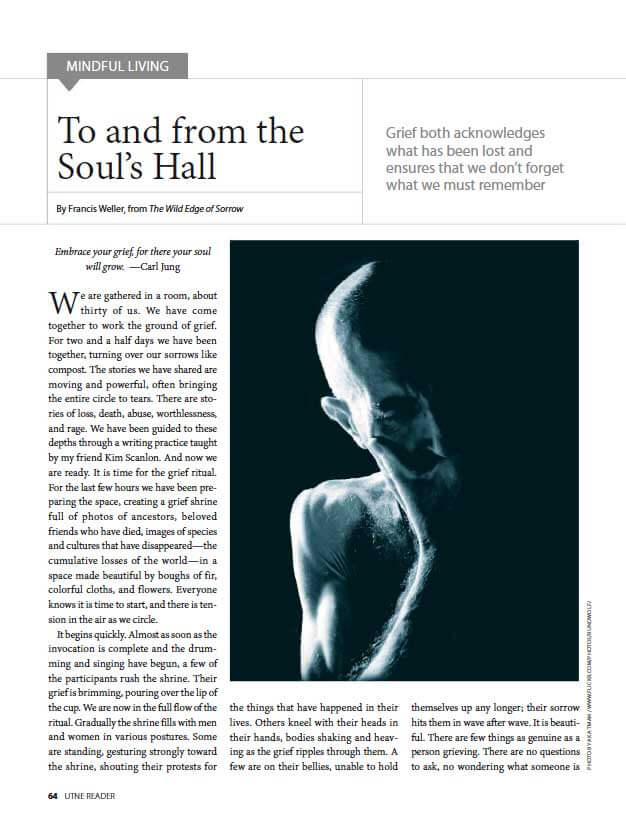
Embrace your grief, for there your soul will grow. —Carl Jung
Grief both acknowledges what has been lost and ensures that we don’t forget what we must remember.
We are gathered in a room, about thirty of us. We have come together to work the ground of grief. For two and a half days we have been together, turning over our sorrows like compost. The stories we have shared are moving and powerful, often bringing the entire circle to tears. There are stories of loss, death, abuse, worthlessness, and rage. We have been guided to these depths through a writing practice taught by my friend Kim Scanlon. And now we are ready. It is time for the grief ritual. For the last few hours we have been preparing the space, creating a grief shrine full of photos of ancestors, beloved friends who have died, images of species and cultures that have disappeared—the cumulative losses of the world—in a space made beautiful by boughs of fir, colorful cloths, and flowers. Everyone knows it is time to start, and there is tension in the air as we circle.
It begins quickly. Almost as soon as the invocation is complete and the drumming and singing have begun, a few of the participants rush the shrine. Their grief is brimming, pouring over the lip of the cup. We are now in the full flow of the ritual. Gradually the shrine fills with men and women in various postures. Some are standing, gesturing strongly toward the shrine, shouting their protests for the things that have happened in their lives. Others kneel with their heads in their hands, bodies shaking and heaving as the grief ripples through them. A few are on their bellies, unable to hold themselves up any longer; their sorrow hits them in wave after wave. It is beautiful. There are few things as genuine as a person grieving. There are no questions to ask, no wondering what someone is feeling. It is self-evident. We are revealing the heartache we carry, the sorrows we have shouldered for decades. We are in the tumult of releasing our tears. This is a holy night, and we go on for hours.
No one is alone at the shrine. Every person pouring grief from their warehouse of sorrows is being attended by another. This is not a time to go it alone. Attendants are there to witness and to provide whatever support is needed. Sometimes this means simply holding space for their deep work. Sometimes it means placing a hand on the person so he can feel that he is not alone. For others, the attendant becomes the lap into which the grieving person can crawl to weep her most bitter tears. This display of compassion is an essential piece in our ability to truly lay down our sorrows.
As we slowly come to the end of the ritual, there is a mixture of elation and exhaustion in the air. This form of soul maintenance is hard work, but it is necessary to keep us available to life. As we close, the participants are moving and swaying to the song we have been singing for hours. Their tears have washed them clean, and their faces are shining. The room is lighter. The participants’ bodies are giddy with joy—a wild alchemy of sorrow and joy, played out once again, as it always has been, in the container of sacred ritual.
And now we move around the circle and embrace one another, thankful for where we traveled and for the work we have done. It is time for cookies and fruit, for water and rest. For the time being, we are released from the weight of grief, but we know full well that tomorrow, when we return to our daily lives, we will begin to gather more. That is the way of things. Knowing, however, that we will come together again in a year—or perhaps sooner, as the need arises—reassures the psyche that we will not have to carry this burden alone for long.





